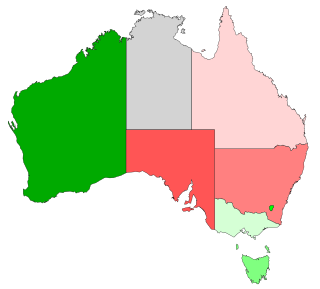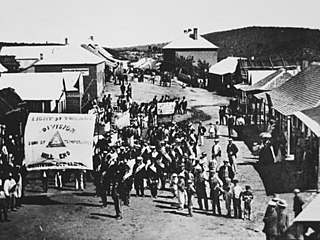
The temperance movement is a social movement against the consumption of alcoholic beverages. Participants in the movement typically criticize alcohol intoxication or promote complete abstinence from alcohol (teetotalism), and its leaders emphasize alcohol's negative effects on people's health, personalities and family lives. Typically the movement promotes alcohol education and it also demands the passage of new laws against the sale of alcohol, either regulations on the availability of alcohol, or the complete prohibition of it. During the 19th and early 20th centuries, the temperance movement became prominent in many countries, particularly in English-speaking, Scandinavian, and majority Protestant ones, and it eventually led to national prohibitions in Canada, in Norway and in the United States, as well as provincial prohibition in India. A number of temperance organizations exist that promote temperance and teetotalism as a virtue.

The 1916 Australian referendum on compulsory military service was held on 28 October 1916. It was the first non-binding Australian referendum, and contained one question. This referendum was held due to Prime Minister Billy Hughes's desire to conscript young Australian men for overseas service during World War I. It was conducted under the Military Service Referendum Act 1916.

Australia uses three main time zones: Australian Western Standard Time, Australian Central Standard Time, and Australian Eastern Standard Time. Time is regulated by the individual state governments, some of which observe daylight saving time (DST). Australia's external territories observe different time zones.

The six o'clock swill was an Australian and New Zealand slang term for the last-minute rush to buy drinks at a hotel bar before it closed. During a significant part of the 20th century, most Australian and New Zealand hotels shut their public bars at 6 pm. A culture of heavy drinking developed during the time between finishing work at 5 pm and the mandatory closing time only an hour later.
The following lists events that happened during 1916 in Australia.

Joseph Coles Kirby was an English flour miller who migrated to Sydney, Australia in 1854. In 1864, Kirby was ordained in the Congregational Churches and then ministered to rural and city congregations in Queensland and South Australia and supported or led many causes for social reform such as the temperance movement, women's suffrage and raising the age of consent to 16 in Australia.
An Ontario prohibition referendum was held on October 20, 1919 on the legality of alcoholic beverages and the maintaining of prohibition. Prohibition had been passed by the provincial government in 1916 under the Ontario Temperance Act, though a clause required a referendum to be held in 1919 on whether the Act should be repealed and the previous licensing laws subsequently revived. A subsequent Act in 1919 provided three further questions for consideration, and subsequent implementation on approval. A majority voted against all four questions, and prohibition was maintained.

Albert Lane was an Australian politician. He was a Nationalist Party member of the New South Wales Legislative Assembly for Balmain from 1922 to 1927 and a United Australia Party member of the Australian House of Representatives from 1931 to 1940.

Alcohol has been consumed in New Zealand since the arrival of Europeans. The most popular alcoholic beverage is beer. The legal age to purchase alcohol is 18.
The 1915 Alberta liquor plebiscite was a plebiscite held on July 21, 1915 to ask Alberta voters whether the Government of Alberta should ratify the proposed Liquor Act. Once ratified, the Liquor Act enforced prohibition in Alberta.

A referendum on the hours for the sale of liquor in hotel bars was held in New Zealand on 9 March 1949. Voters were asked whether they favoured continuing the closing of hotel bars at 6 pm or extending the closing time to 10 pm. The change was rejected by 75.5% of voters.

A referendum on the hours for the sale of liquor in hotel bars was held in New Zealand on 23 September 1967. Voters were asked whether they favoured continuing the closing of hotel bars at 6 pm or later closing, the actual hours of sale to be decided according to local conditions. The change was favoured by 64.5% of voters.

The temperance movement has been active in Australia. As with the movement internationally, in Australia it has sought to curb the drinking of alcohol. The temperance movement had some success in the early twentieth century, although from the Second World War its influence declined. Nevertheless, temperance organisations remain active today.

The temperance movement in New Zealand originated as a social movement in the late-19th century. In general, the temperance movement aims at curbing the consumption of alcohol. Although it met with local success, it narrowly failed to impose national prohibition on a number of occasions in the early-20th century. Temperance organisations remain active in New Zealand today.
A referendum concerning the reduction of the members of the New South Wales Legislative Assembly was put to voters on 16 December 1903, in conjunction with the 1903 federal election. The referendum was conducted on the basis of optional preferential voting. However, preferences were not counted, as an overwhelming majority voted to reduce the number of members to 90.
A referendum concerning the closing hour for licensed premises and registered clubs was put to voters on 15 February 1947. The referendum was conducted on the basis of optional preferential voting. Preferences were not counted as a majority voted to maintain the 6:00 pm closing time.
A referendum concerning the closing hour for licensed premises and registered clubs was put to voters in New South Wales on 15 February 1954.
A referendum concerning introducing prohibition in New South Wales was put to voters on 1 September 1928.
A referendum concerning whether hotels should be allowed to trade on Sundays was put to voters in New South Wales on 29 November 1969 but was unsuccessful.
A referendum concerning whether daylight saving should be continued in New South Wales was put to voters in conjunction with the state election on 1 May 1976 and was carried with a comfortable majority.









